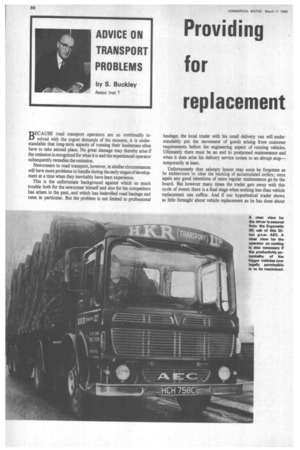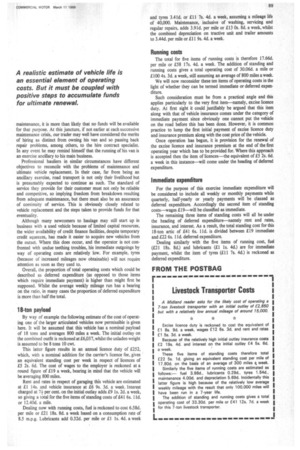Providing for replacement
Page 90

Page 91

Page 92

If you've noticed an error in this article please click here to report it so we can fix it.
LIPECAUSE road transport operators are so continually involved with the urgent demands of the moment, it is understandable that long-term aspects of running their businesses often have to take second place. No great damage may thereby arise if the omission is recognized for what it is and the experienced operator subsequently remedies the omission.
Newcomers to road transport, however, in similar circumstances will have more problems to handle during the early stages of development at a time when they inevitably have least experience.
This is the unfortunate background against which so much trouble both for the newcomer himself and also for his competitors has arisen in the past, and which has bedevilled road haulage and rates in particular. But the problem is not limited to professional haulage; the local trader with his small delivery van will understandably put the movement of goods arising from customer requirements before the engineering aspect of running vehicles. Ultimately there must be an end to postponed maintenance and when it does arise his delivery service comes to an abrupt stop— temporarily at least.
Unfortunately that salutary lesson may soon be forgotten as he endeavours to clear the backlog of accumulated orders; once again any good intentions of more regular maintenance go by the board. But however many times the trader gets away with this cycle of events there is a final stage when nothing less than vehicle replacement can suffice. And if our hypothetical trader shows as little foresight about vehicle replacement as he has done about maintenance, it is more than likely that no funds will be available for that purpose. At this juncture, if not earlier at each successive maintenance crisis, our trader may well have considered the merits of hiring as distinct from owning his van and so passing back repair problems, among others, to the hire contract specialist. In any event he may remind himself that the running of his van is an exercise ancillary to his main business.
Professional hauliers in similar circumstances have different objectives to reconcile with the problems of maintenance and ultimate vehicle replacement. In their case, far from being an ancillary exercise, road transport is not only their livelihood but is presumably expected to continue as such. The standard of service they provide for their customer must not only be reliable and competitive, so implying freedom from breakdown resulting from adequate maintenance, but there must also be an assurance of continuity of service. This is obviously closely related to vehicle replacement and the steps taken to provide funds for that eventuality.
Although many newcomers to haulage may still start up in business with a used vehicle because of limited capital resources, the wider availability of credit finance facilities, despite temporary credit squeezes, has made it easier to acquire new vehicles from the outset. Where this does occur, and the operator is not confronted with undue teething troubles, his immediate outgoings by way of operating costs are relatively low. For example, tyres (because of increased mileages now obtainable) will not require attention as soon as they used to.
Overall, the proportion of total operating costs which could be described as deferred expenditure (as opposed to those items which require immediate payment) is higher than might first be supposed. Whilst the average weekly mileage run has a bearing on the ratio, in many cases the proportion of deferred expenditure is more than half the total.
18-ton payload
By way of example the following estimate of the cost of operating one of the larger articulated vehicles now permissible is given here. It will be assumed that this vehicle has a nominal payload of 18 tons and averages 800 miles a week. The initial outlay on the combined outfit is reckoned at £6,037, whilst the unladen weight is assumed to be 8 tons 10 cwt.
This latter figure results in an annual licence duty of £252, which, with a nominal addition for the carrier's licence fee, gives an equivalent standing cost per week in respect of licences of £5 2s. 6d. The cost of wages to the employer is reckoned at a round figure of £19 a week, bearing in mind that the vehicle will be averaging 800 miles.
Rent and rates in respect of garaging this vehicle are estimated at £1 14s. and vehicle insurance at £6 9s. 3d. a week. Interest charged at 7÷ per cent. on the initial outlay adds £9 Is. 2d. a week, so giving a total for the five items of standing costs of £41 6s. 11d. or 12.40d. a mile.
Dealing now with running costs, fuel is reckoned to cost 6.58d. per mile or £21 18s. 8d. a week based on a consumption rate of 8.5 m.p.g. Lubricants add 0.32d. per mile or £1 is. 4d. a week and tyres 3.41d. or £11 7s. 4d. a week, assuming a mileage life of 40,000. Maintenance, inclusive of washing, servicing and regular repairs, adds 3.91d. per mile or £13 Os. 8d. a week, whilst the combined depreciation on tractive unit and trailer amounts to 3A4th per mile or £11 9s. 4d. a week.
Running costs
The total for five items of running costs is therefore 17.66d. per mile or £58 17s. 4d. a week. The addition of standing and running costs gives a total operating cost of 30.06d. a mile or £100 4s. 3d. a week, still assuming an average of 800 miles a week.
We will now reconsider these ten items of operating costs in the light of whether they can be termed immediate or deferred expenditure.
Such consideration must be from a practical angle and this applies particularly to the very first item-namely, excise licence duty. At first sight it could justifiably be argued that this item along with that of vehicle insurance comes under the category of immediate payment since obviously one cannot put the vehicle on the road before this has been done. However, it is common practice to lump the first initial payment of excise licence duty and insurance premium along with the cost price of the vehicle.
Once operation has begun, it is provision for the renewal of the excise licence and insurance premium at the end of the first operating year which has to be provided for. Where this approach is accepted then the item of licences-the equivalent of £5 2s. 6d. a week in this instance--will come under the heading of deferred expenditure.
Immediate expenditure
For the purpose of this exercise immediate expenditure will be considered to include all weekly or monthly payments while quarterly, half-yearly or yearly payments will be classed as deferred expenditure. Accordingly the second item of standing costs-wages £19-will be classified as immediate.
The remaining three items of standing costs will all be under the heading of deferred expenditure-namely rent and rates, insurance, and interest. As a result, the total standing cost for this 18-ton artic of £41 6s. I Id. is divided between £19 immediate and £22 6s. 11d. deferred expenditure.
Dealing similarly with the five items of running cost, fuel (£21 18s. 8d.) and lubricants (£1 Is. 4d.) are for immediate payment, whilst the item of tyres al 1 7s. 4d.) is reckoned as deferred expenditure. Maintenance, however, needs special consideration. It is common practice to do a minimum of washing and greasing weekly no matter how new a vehicle; accordingly an arbitrary amount of £1 is put under the heading of immediate expenditure whilst the balance of the maintenance cost (£12 Os. 8d.) is allocated as deferred expenditure.
Of all the ten items, depreciation is obviously the most "deferred" item of expenditure. The resulting split of running costs is thus: immediate expenditure £24; deferred expenditure £34 17s. 4d. Similarly the total operating cost of £100 4s. 3d. incurred in averaging 800 miles a week with this 18-ton artic is divisible as between £43 immediate and £57 4s. 3d. deferred expenditure.
Initial outlay
I mentioned earlier that the proportions will vary with differing vehicles according to the amount of initial outlay and the average mileage run. Where the mileage is high, as in this case, the item of fuel—an obvious immediate expense—is correspondingly high with an effect on the overall proportion. However, the effect of high initial outlay is in the opposite direction; but to some extent this is balanced out because, except for specialized vehicles, the higher initial outlay would normally be associated with high mileage.
Having determined beforehand the likely split between immediate and deferred expenditure as well as the total amount involved it is unlikely that the haulier would subsequently undercharge customers for services provided through ignorance of his true operating costs. But the need still remains for him to make positive provision for these several items of deferred expenditure for the day when payment is actually required.








































































































































